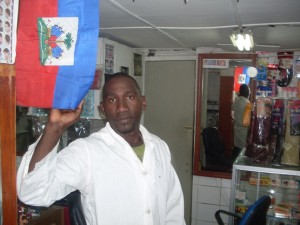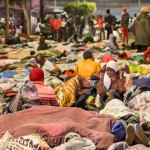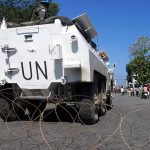Haiti’s Depopulation: A Globalist Project
By Dady Chery
Haiti Chery
A full two-thirds of the earthquake casualties in Haiti on January 12, 2010 were directly due to policies that the Inter-American Development Bank (IDB), World Bank, and United States Agency for International Development (USAID) put in place to create surplus labor for the country’s sweatshops. The now well-known reductions in the tariffs on agricultural products, flood of subsidized Arkansas rice on the Haitian market, and eradication of the locally adapted creole pig were all components of a well mapped-out plan to impoverish Haitian farmers and force their migration from their villages to the capital city of Port-au-Prince. In this way, about 1.6 million Haitians were added in 30 years to about 800,000 people who were already in the area that would become the earthquake’s epicenter. Since that disaster, there has been a nearly complete eradication of Haitian agriculture and a simultaneous dissipation of the Haitian population to prevent a major famine and popular revolt. This process has required a collaboration of the Latin American member countries of the United Nations’ so-called peacekeeping mission (MINUSTAH) and Haiti’s richest families.
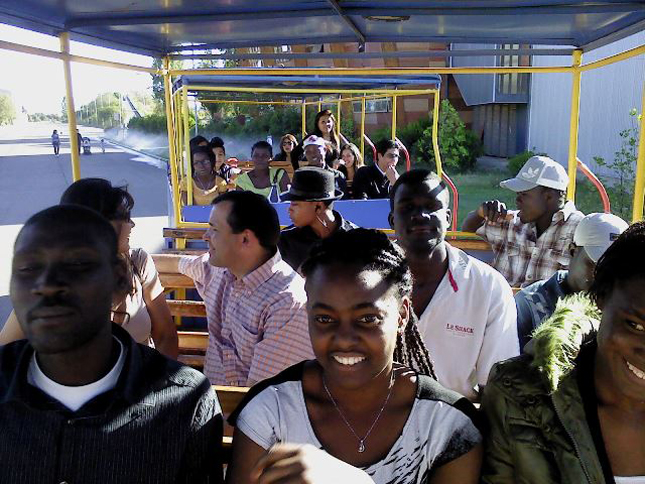
A zero-employment remittance economy
Most countries would not give up their middle class without first being destroyed by a war, as nearly happened in Syria. Haiti’s government, however, is not representative; in fact, it is, for the most part, inimical to its own population. On the subject of emigration, Haitian industrialists make common cause with the globalist project to depopulate Haiti and disenfranchise Haitians. This supposed elite believes that one can base an economy entirely on money transfers from abroad. It has observed, while licking its lips, that the roughly $2 billion sent to Haiti per year by those Haitians who live abroad represents more than 20 percent of the Gross Domestic Product (GDP). Furthermore, those remittances often exceed foreign aid or direct foreign investment, which are considered to be less reliable because they depend on political decisions and market forces. Nearly all the remittances have traditionally come from Haitians in the Dominican Republic, United States, Canada, the Bahamas, and France, where the great majority of the diaspora, about 2 million in all, reside. This began to change, however, when the Haitian government set out to achieve more than 90 percent unemployment at home and deliberately create a diaspora in Latin America to generate more remittances.

Ecuador opens its door
The start of the movement of Haitians toward Central and South America preceded the earthquake by two years and was not due to homelessness from that disaster. In July 2008, the Ecuadorian government dropped all its visa requirements and threw open its doors to immigrants and asylum seekers. From the start, this project involved Haitian and Ecuadorian human traffickers who were probably in league with their governments. The first Haitians to fall into their clutches were young adults who aspired to continue their studies abroad. In one well-documented case, four Haitians between 17 and 28 years old were lured to Ecuador with promises of full scholarships and then imprisoned in a house for nearly a year while being forced to pay $150 per month for their rent and board. A requirement of their scholarship had been to prove that they had family members in the US or Canada who could pay for their registration fee of about $300. The monthly payments were subsequently extorted from those families. The Ecuadorian government was not much better than the coyotes. In response to the earthquake in 2010, it legalized the status of 390 Haitians but left about 1,000 others to the whims of human traffickers and abusive employers. By 2015, the number of irregular Haitian immigrants had grown to about 20,000. In May of that year, Ecuador announced that it would grant six-month nonimmigrant visas to all Haitian nationals illegally on its soil, after which they could apply for migrant visas. It is unclear how many Haitians have regularized their situations by this approach.
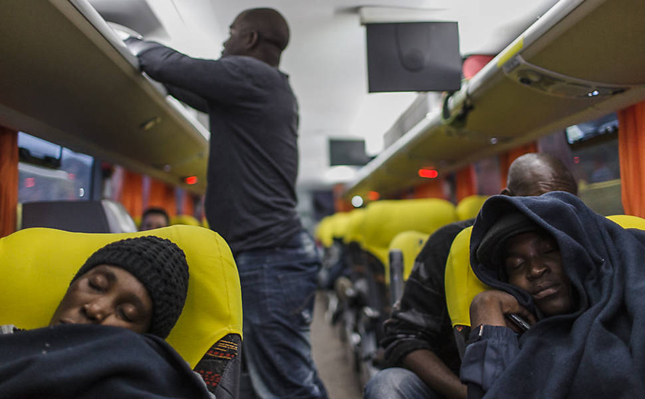
Dilma does visas
Thanks to Brazil’s healthy judicial system, many of the Brazilian construction concerns and politicians who instigated the sordid traffic of Haitians to Brazil for slave labor are now out of business, in prison, or both, for other crimes. Like Ecuador, Brazil threw open its doors to unsuspecting Haitians, but its sudden generosity with visas involved no humanitarian concern. An aggressive recruitment of Haitians by Dilma Rousseff immediately followed a Brazilian workers’ revolt in spring 2011, more than a year after the earthquake. One aim of the visas was to generate a captive scab labor force for dangerous jobs like the construction of stadiums, mines, bridges, and hydroelectric dams. Such workers could have easily been drawn from a pool of unskilled laborers, like the Haitians in the Dominican Republic, but there was another aim, and this was to free Haiti of a group of potentially troublesome citizens. Seventy-seven percent of those trafficked to Brazil were male, and more than 90 percent were educated and between 19 and 45 years old.
When the migration of Haitians to Brazil began to slow down, around summer 2015, after one Haitian was killed and five others injured, Brazil renewed its offer of visas. “All Haitians will be welcome in Brazil: those who arrive legally just as those who arrive undocumented,” announced the new Brazilian Ambassador to Haiti, Fernando Vidal, on October 6, 2015. And when a journalist asked “even if all 10 million Haitians decide to go over there?” Vidal explained, “There is no ceiling, no requirement, and no constraint.” One month later, Brazil made a big show of granting permanent residency to 58 percent of its then total of about 76,000 Haitians. Subsequently, it let the Haitian population grow to more than 100,000. After the massive corruption of Rousseff’s party began to make itself felt as an economic recession in 2016, the Brazilian jobs dried up, as did the visas.

Next stop, Chile
In Chile, a migration of Haitians also began around 2011, but between 2011 and early 2016, the population of migrants never reached a size comparable to that of Brazil and appeared to level at about 9,000. Those were mostly students; 80 percent were between 15 and 30 years old, and about 65 percent were female. Since a visa was not required to enter Chile, they needed only their passport and an airlines ticket. Generally, they traveled by plane from Port-au-Prince to Santiago, with a stop in Panama City. Though they were not trafficked on land, as happened in the other cases, they were still heavily exploited. This took the form of excessive charges for their tickets (more than $2,300) and unorthodox travel fees of hundreds of dollars. On their arrival in Chile, many found that their Haitian diplomas were not accepted for credit. Worse, some discovered after four to five years of study that their academic institutions would not grant them their degrees. In August 2016 the Haitian population in Chile suddenly exploded to more 40,000, when Haitians began to leave Brazil at a rapid rate due to a lack of jobs. Another 50,000 Haitians were expected to settle in Chile from Brazil in 2017; by March 2017, the total number in Chile had already reached 60,000.
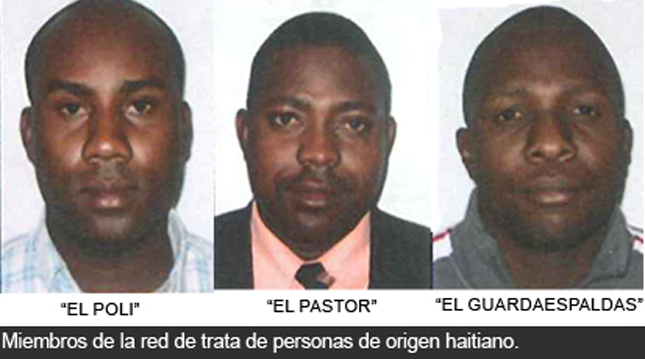
“El Poli” is Luis Ramirez, a Dominican; “El Pastor” is Cedanus Dorvil, and “El Guardaespaldas” is Jean Blendy Mahotiere, both Haitians. Their human trafficking network brought Haitians into Santiago, Chile, and dumped them in the streets (Photo: Gustavo Villarrubia and Juan Pablo Figueroa).
The superhuman trek to Mexico
Another group of Haitians chose to move from Brazil, by a land route, to the United States. According to a report by Christiane Ndedi Essombe, about 5,000 have made their way to San Ysidro, just south of San Diego. Others wait in Tijuana and Mexicali to cross the border into the US. In all cases, they live under abominable conditions, often in well-meaning churches that lack the beds or bathrooms to accommodate all of them. Many of the migrants are well-educated people who have given up on ever using their training. For example, one civil engineer had become a plumber in Brazil. During a series of interviews, Ms. Essombe discovered that each had spent $3,000 to $5,000 and traveled for three months through forests, mountains, deserts and rivers, being palmed off from one human trafficker to another. From Brazil, the migrants crossed into Peru, Ecuador, Colombia, Panama, Costa Rica, Nicaragua, Honduras, and Guatemala, to arrive in Mexico at Tapachula and continue northward. They generally agreed that the border between Colombia and Panama was their most dangerous passage. Some say they witnessed the deaths of men, women, and children there.

Where do we go from here?
Haiti appears to be endeavoring to become a country with only a political class, a military and police class, and a sweatshop class. The middle class will not be in Haiti but will be relegated exclusively to a diaspora that can send remittances from abroad. The Haitian government has been reluctant to receive Haitian deportees, accepting only about 50 per month and claiming that the country cannot establish the citizenship of most others. Meanwhile, thousands of impoverished Haitians and even Dominicans are dumped every week into Haiti from the Dominican Republic (DR) because of decisions that were set in motion by the UN in 2013. Indeed, it is estimated that 180,000 people entered Haiti from the DR between June 2015 and March 2017, most of them uneducated and with only the clothes on their backs. In effect, the Haitian rich have been doubled-crossed in their Faustian bargain to discard their own population so as to collect money.
If Haiti has abandoned its recent emigrants, their rejection of Haiti is even more total. Despite an arduous journey, none of the travelers from Brazil to Mexico considered a return to Haiti as a possible way out. Though they all summarized their grievances as a shortage of work in Haiti, I believe that one could easily add to this complaint a total collapse of the state apparatus, an absence of the law, routine land grabs, runaway inflation, skyrocketing food prices, and a regular sabotage of potable water systems that have made life unbearable.
“If everybody leaves Haiti, what’s going to happen there?” Christiane Ndedi Essombe asked one of the travellers.
J: “I don’t know. As far as I am concerned, if everybody had an opportunity to get out, it would be better.”
N: “But if one leaves, things will never change. [The government] will continue to do what it wants.”
J: “I understand. I, who have children, cannot stay there. If I stay, I have nothing to give them. I can do what there? I spent 14 years in school for nothing. For nothing….”
Those migrants, who have made a superhuman effort to guide their own destinies, could never imagine themselves to be leaves blown to the winds, eventually to crumble and disappear: the subjects of a vile experiment to ablate nationalism and citizenship so that territories and people may be better controlled by supranational entities like the UN, IDB, and World Bank.
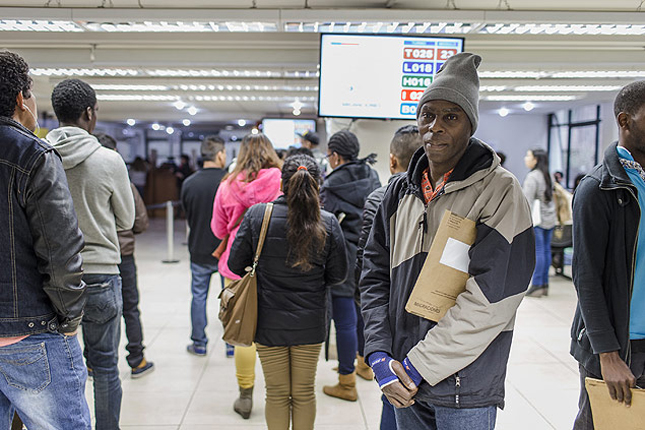
Sources: Updated on March 28, 2017 | Dady Chery is the author of We Have Dared to Be Free. | Photos one and two by Victor Farinelli; three, four, five, six, and eight by Avener Prado, seven from Centro de Investigacion Periodistica (CIPER) | This article has been translated into Italian.

